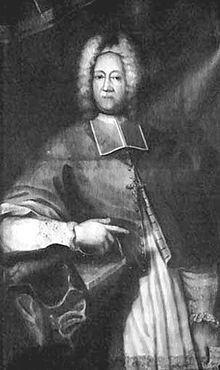Georg Ludwig von Berghes
Georg Ludwig von Berghes (baptized September 5, 1662 in Brussels , † December 5, 1743 in Liège ) was Prince-Bishop of Liège .
Life
He was the son of Eugen von Berghes and Grimmbergen († October 29, 1670) and Florentina Margarethe Countess of Renesse-Warfusee († February 24, 1665). Up to the age of 34 he was a military in Spanish service and finally a lieutenant colonel in the cavalry .
In 1694 he became canon in Liège. Shortly before that, the Elector of Cologne , Joseph Clemens of Bavaria , had been appointed Bishop of Liège. This appointed Berghes his privy councilor and chamber president. During the quarrel between the emperor and the elector - whereby the emperor withdrew his land from the elector - the cathedral chapter had to take over the government. When the elector died, the cathedral chapter elected Georg Ludwig von Berghes as his successor on February 7, 1724. After receiving papal confirmation on September 27th, he entered government. On December 4th he took possession of the cathedral church and was ordained a priest on December 10th . He read his first mass on December 11th and was ordained a bishop on December 31st, 1724 . The award of the imperial fief by Emperor Charles VI. took place on July 14, 1725.
In 1733 he tried to enforce the bull Unigenitus Dei filius in Maastricht , which led to some unrest. When the war of succession to the Polish throne came in 1733 , he was able to keep the Principality of Liège out by allowing both parties to advertise and paying taxes to the German Empire as well as contributions to the French. Many documents from this period were lost in a fire in the palace on March 24, 1734.
In 1735 he clashed with the government of the Austrian Netherlands . The cause was the Count von Arberg, who wanted to raise customs from his castle La Rochette on the Vestre river. The bishop was of the opinion that the castle was in Liège territory and had the customs post cleared. The count sued in Brussels and stated that the castle was in the province of Limburg and that the bishop had exceeded his powers. Thereupon the government confiscated the property of the Liège in Brabant . The bishop in turn confiscated the property of the Brabantians in Liège. The conflict lasted from 1735 to 1740. Then it was agreed to restore the status before the conflict.
The next problem for the government became the glory of Herstal . It was a Prussian property and had long been a thorn in the side of the bishop. After a few provocations, the new Prussian King Frederick II sent troops to occupy the town of Maaseik and to collect some contributions . The bishop protested in Paris, at the States General and before the Imperial Court, but nobody wanted to intervene. So he sent his chief steward, the Count of Horion, to negotiate in Berlin. A settlement was agreed, the bishop paid 120,000 guilders and had to redeem another 30,000 patacons from 1690 (according to Prussian sources: 260,000 guilders and 60,000 patacons). For that he could keep the glory.
In 1741 the War of the Austrian Succession broke out and Liège became a marching area for French troops under Marshal Maillebois . In 1742 Kurhannoversche and Hessian troops moved in for the British army and took winter quarters. The bishop protested violently at the courts, but the troops did not leave until February 1742.
Von Berghes died on December 5, 1743 of complications from a stroke on the night of November 28 to 29 and was buried in the Liège Lambertus Cathedral.
literature
- Christian von Stramberg , Anton Joseph Weidenbach : Memorable and useful Rheinischer Antiquarius. Volume 12, Part 3, pp. 235ff. Digitized
- Antoine Godea et al. a .: General Church History. Volume 24, pp. 218ff. Digitized
Web links
| predecessor | Office | successor |
|---|---|---|
| Joseph Clemens of Bavaria |
Bishop of Liège 1724–1743 |
Johann Theodor of Bavaria |
| personal data | |
|---|---|
| SURNAME | Berghes, Georg Ludwig von |
| BRIEF DESCRIPTION | Prince-Bishop of Liege |
| DATE OF BIRTH | baptized September 5, 1662 |
| PLACE OF BIRTH | Brussels |
| DATE OF DEATH | December 5, 1743 |
| Place of death | Liege |
